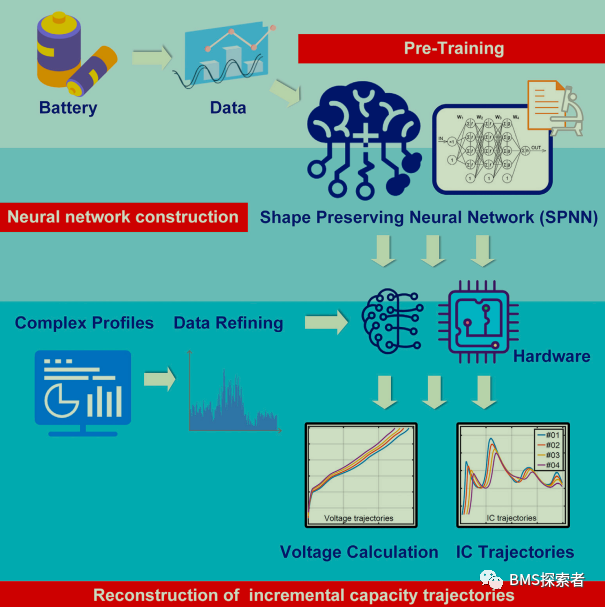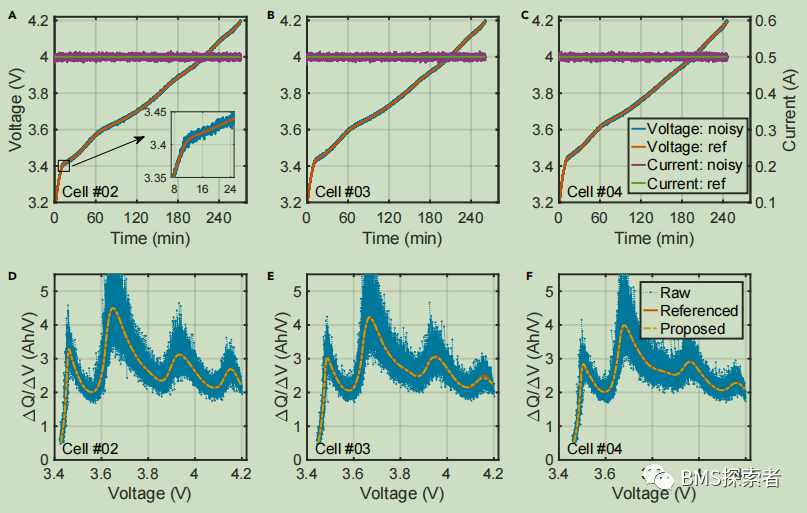
Reliable assessment of battery degradation is the basis for safe and efficient battery utilization. As an important in situ health diagnosis method, incremental capacity (IC) analysis is highly dependent on low noise constant current curve, which violates the reality. Here, a model free fitting process is used to reconstruct IC trajectories from noise and even current varying contours. According to the results of 22 batteries and 3 case studies, the error of peak position in the reconstructed IC trajectory can only be limited to 0.25%. By extracting health indicators from the reconstructed IC trajectory, the health status can be easily determined by simple linear mapping, and the estimation error is only less than 1%. By implementing an integrated circuit based approach under complex load conditions, enhanced health assessment can be implemented to improve the reliability of power systems and further promote a more sustainable society.

The aim of this work is to reconstruct integrated IC trajectories from complex load distributions, including those with large noise or non constant current distributions. In this way, the IC based method can be extended from laboratory experiments to more real applications, in which the load distribution is a highly dynamic application. Here, we try to reconstruct the incremental capacity trajectory from the complex load profile for the first time. The reconstruction problem was initially described as a curve fitting problem, and an easy to implement average based method was proposed to select representative data from complex load distribution. This paper presents a shape preserving method to fit the selected data and generate a smooth integrated IC trajectory. The effectiveness of this method is verified by three cases: large measurement noise, pulse charging and active equalization packaging charging. From the experimental results of 22 batteries with different aging degrees (from our previous cyclic aging test, this method can accurately capture the peak position in the IC track, with an error of only 0.25%. Although SOH estimation is not the main objective of this paper, it can still be accurately determined when the error range is 1%. Since the proposed method does not depend on specific battery models, it can be directly applied to different types of batteries, paving the way for effective and reliable battery health assessment 。
ICA is one of the most important in situ methods for battery health assessment, but it is usually limited by its dependence on low-noise constant current curve. To solve this problem, we reconstruct IC trajectories from complex electrorheological profiles. This task is initially described as a curve fitting problem, and then an easy to implement preserving fitting method is developed by redesigning the activation function of the neural network. IC trajectory fitting is based on the relationship between "voltage and time". The feasibility of our method is based on 22 battery use scenarios. The experimental results show that the IC trajectory can be recovered accurately. In all test cases, the peak positioning error of all peaks is 0.25%. In addition, SOH can be accurately estimated through the extracted IC trajectory, and the error is only 1%, even if it is not explicitly considered as the research goal here. This paper is the first report to extract IC circuit trajectory from complex load profiles, such as considering pulse charging or active packet balancing. In addition, the proposed IC reconstruction method is model free, so it is suitable for general battery types.
In this paper, we mainly focus on extracting IC trajectories from noise or non constant current contours. However, the detailed utilization of the extracted IC trajectories, such as extracting SOH from IC trajectories with different temperatures and current rates or determining the reaction kinetics of the battery, is beyond the discussion of this work and needs further research. If the current interest rate is so large that small peaks in the IC trajectory are submerged, the performance of this method may be significantly reduced. Cost effective methods to deal with inaccurate measurements, such as the use of dual observer techniques, are also worth discussing. In addition, as a common problem of data segmentation algorithm, the lack of physical insight of battery may reduce the generalization and reliability of the method. This problem can be solved by introducing the first principle into the data segmentation machine, which is an interesting future research direction. It is also interesting to verify the proposed method for battery and other chemical and partial charging characteristics.
Traditionally, given the time series response of the battery terminal voltage to the CC curve, the IC value at the time step k can be

because δ In the denominator of the V term, the IC value may be very sensitive to the fluctuation of the voltage measurement, which is not only caused by the measurement noise, but also by the change of the current (for example, the current change curve). In general, estimating the change of voltage from a given current requires a high fidelity battery model considering battery degradation (liuetal., 2020). However, one of the most important applications of IC trajectory itself is to evaluate the degree of aging. Therefore, it is not feasible to use model-based method to estimate battery voltage and reconstruct integrated IC trajectory, because this process will lead to cycle dependence. In this case, another method is proposed, that is, the reconstruction of IC trajectory is expressed as a curve fitting problem. It is noted that the original IC trajectory is highly jittery in the case of noise or non constant current, so it is difficult to determine a reliable "ICVS voltage" data pair to support curve fitting. Therefore, the purpose here is to reconstruct the "voltage and time" trajectory of the noise free constant current contour from the data that may contain unsteady current and large measurement noise, and then calculate the corresponding IC trajectory. In the framework of general curve fitting, our method can be divided into three sub steps:
Obtain input (time) and output (voltage). 2. fit the input-output relationship. 3. calculate IC trajectory according to fitting results
Select four sonyus18650vtc5 batteries with different aging degrees (rated capacity: qnom=2.5ah), of which the latest cell (�1) is used to establish the activation function g (,) and initialize the neural network, as shown in the figure, while the other three batteries are used for verification. Table 1 lists the SOH of these four batteries (soh here is defined by soh=q/qnom, where q is the actual capacity). The voltage, current and IC trace of batteries �2, �3 and �4 are shown in the figure. The errors of peak and peak position are also listed in Table 2. From these results, it can be seen that this method can accurately recover the IC trajectory from the noise measurement. The error of peak value can be well controlled within 1%, and for batteries with different aging degrees, the error of peak value position can be limited within 0.2%. This high accuracy proves that the algorithm is effective for measuring the constant current charging curve with high noise.






 Home
Home Products
Products Telephone
Telephone Message
Message






